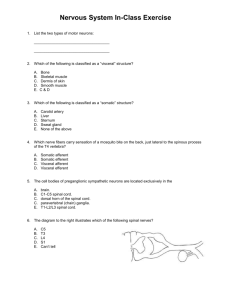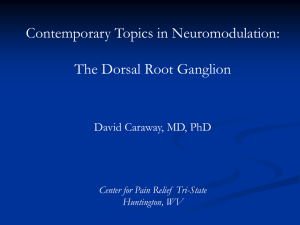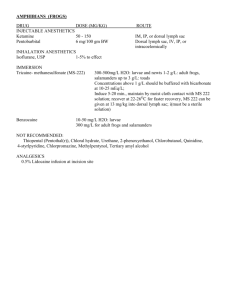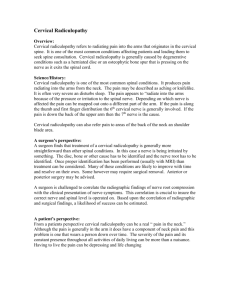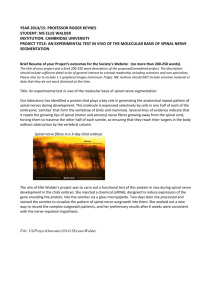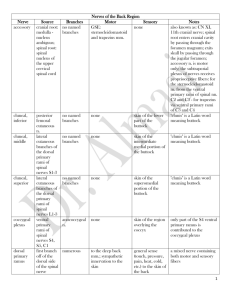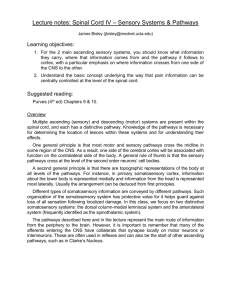Neuroscience & Pharmacology Exam Questions
advertisement
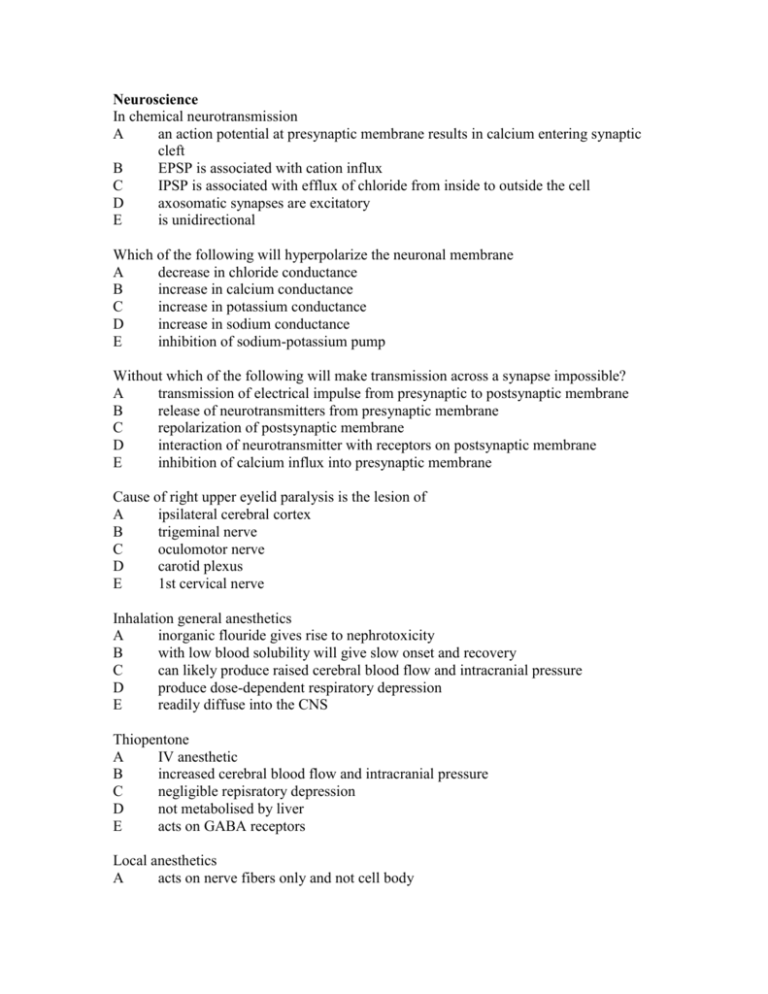
Neuroscience In chemical neurotransmission A an action potential at presynaptic membrane results in calcium entering synaptic cleft B EPSP is associated with cation influx C IPSP is associated with efflux of chloride from inside to outside the cell D axosomatic synapses are excitatory E is unidirectional Which of the following will hyperpolarize the neuronal membrane A decrease in chloride conductance B increase in calcium conductance C increase in potassium conductance D increase in sodium conductance E inhibition of sodium-potassium pump Without which of the following will make transmission across a synapse impossible? A transmission of electrical impulse from presynaptic to postsynaptic membrane B release of neurotransmitters from presynaptic membrane C repolarization of postsynaptic membrane D interaction of neurotransmitter with receptors on postsynaptic membrane E inhibition of calcium influx into presynaptic membrane Cause of right upper eyelid paralysis is the lesion of A ipsilateral cerebral cortex B trigeminal nerve C oculomotor nerve D carotid plexus E 1st cervical nerve Inhalation general anesthetics A inorganic flouride gives rise to nephrotoxicity B with low blood solubility will give slow onset and recovery C can likely produce raised cerebral blood flow and intracranial pressure D produce dose-dependent respiratory depression E readily diffuse into the CNS Thiopentone A IV anesthetic B increased cerebral blood flow and intracranial pressure C negligible repisratory depression D not metabolised by liver E acts on GABA receptors Local anesthetics A acts on nerve fibers only and not cell body B C D E results into motor and sensory paralysis enhanced reaction during inflammation is in the form of a HCl salt for stability acts by combining with sodium ions Adverse effects of LA include A hypersensitivity B methoglobinemia C convulsions D respiratory failure E renal failure Spinal cord A IML nucleus is found in the sacral segments B cells from dorsal ganglia terminate in dorsal horn C cervical enlargement gives rise to the brachial plexus D spinal nerve exits at the intervetebral foramen E in adults, it terminates at L1/L2 Hemisection of T4 A flaccid paralysis of all four limbs B contralateral loss of pain and temperature sensation C contralateral loss of proprioception D ipsilateral paralysis of motor reflexes E contrateral loss of pain and temperature sensation at xiphisternal joint Loss of proprioception can be result of lesion at A dorsal column B nucleus dorsalis C mesencephalic trigeminal nucleus D dorsal root of cervical nerve Lignocaine A is short acting LA B is least toxic of all LA C inhibits reuptake of norepinephrine D high absorption from mucous membranes E causes myadriasis if applied to eye Corticospinal tract A functions in normally, voluntary skilled movements B contain upper motor neurons in precentral gyrus C decussate at the level of the pons D injury to it at internal capsule leads to stroke E lesion at brainstem leads to crossed symptoms Opioid agonists A have antitussive effects B stimulate the respiratory center C inhibit neurotransmitter release D cause pupillary dilatation at therapeutic doses E cause constipation Tubocuraine A anti-cholinergic B non-depolarizing agent C relatively long duration of action D cause histamine release E binds to nicotinic receptors Action of neurotransmitter termianted by A reuptake by nerve terminal B reuptake by glial cells C calcium dependent release of a chemical which inactivates the neutrotransmitter D enzymatic degradation in the synaptic cleft E passive diffusion of neurotransmitter away from synapse General sensory system A loss of pain sensation in the left leg due to lesion of lateral spinothalamic tract on the right of T1 spinal cord B lesion in right dorsal column at upper cervical level leads to lsos of light touch and pressure in right upper limb C general sensory stem input to cortex has relay in the thalamus D cell bodies of all primary neurons conveying pain sensation are located in the dorsal root ganglia of spinal neurons E muscle spindle afferents from the lower limb synapse in the nucleus gracilis Thalamus A lesion causes sensory loss only Fiber tracts in the spinal cord A in cervical region, fibers from the sacral segment are more superficial than fibers from the lumbar region B lateral corticospinal tract terminate on motor neurons in the ventral horn C in dorsal column, fibers arising from the lumbar region are lateral to the fibers arising from the cervical region D fasiculus gracilis is absent from the lumbar section of the spinal cord Ascending tracts A dorsal colum fibers transmit proprioceptive sensation B the cell bodies of dorsal column fibers are found mainly in the dorsal root ganglia C the medial lemniscus terminate inthe ventral anterior nucleus of the thalamus D the spinothalamic trac tcells termiante predominantly in the dorsal horn Naxolone A is an opioid antagonist B precipitates withdrawal symptoms in morphine addicts C is a common cause of hyperalgesia in humans D antagonizes all CNS depressents
